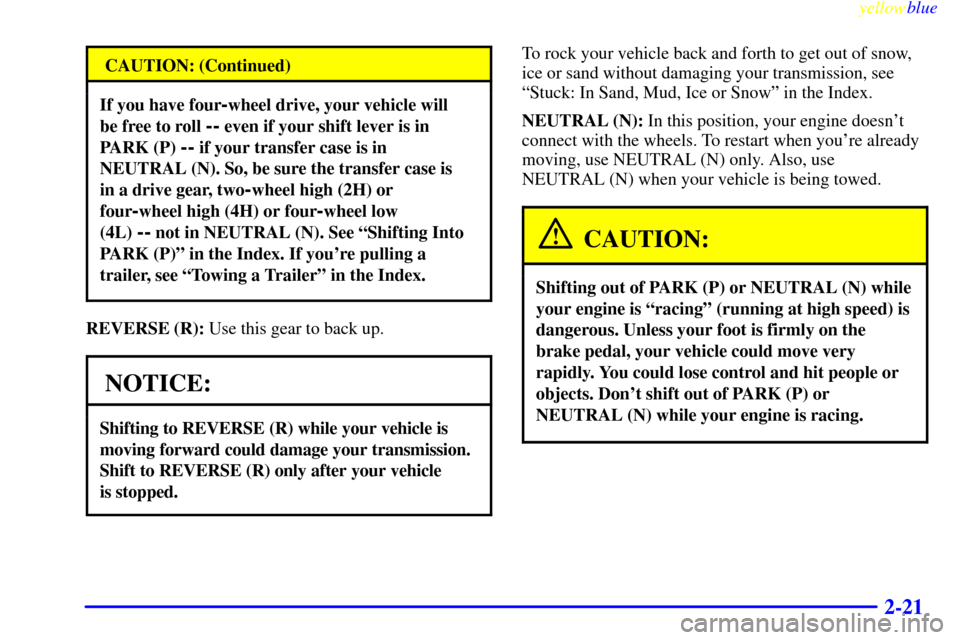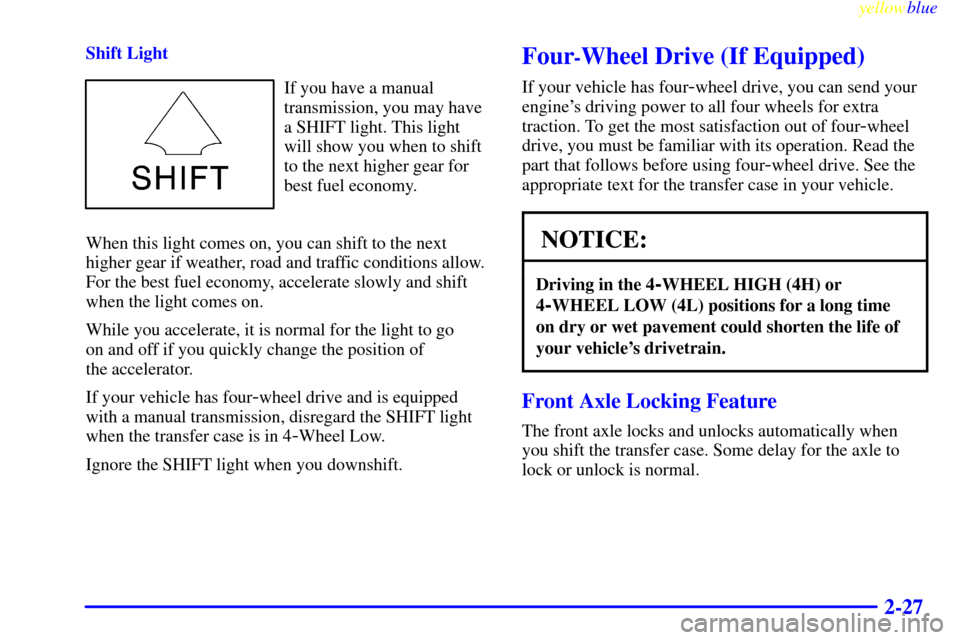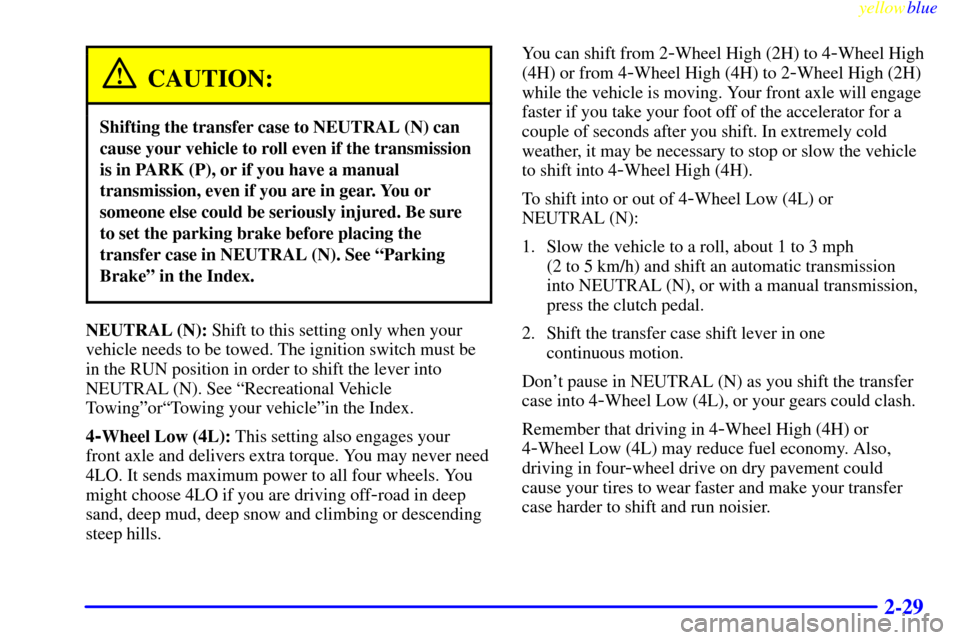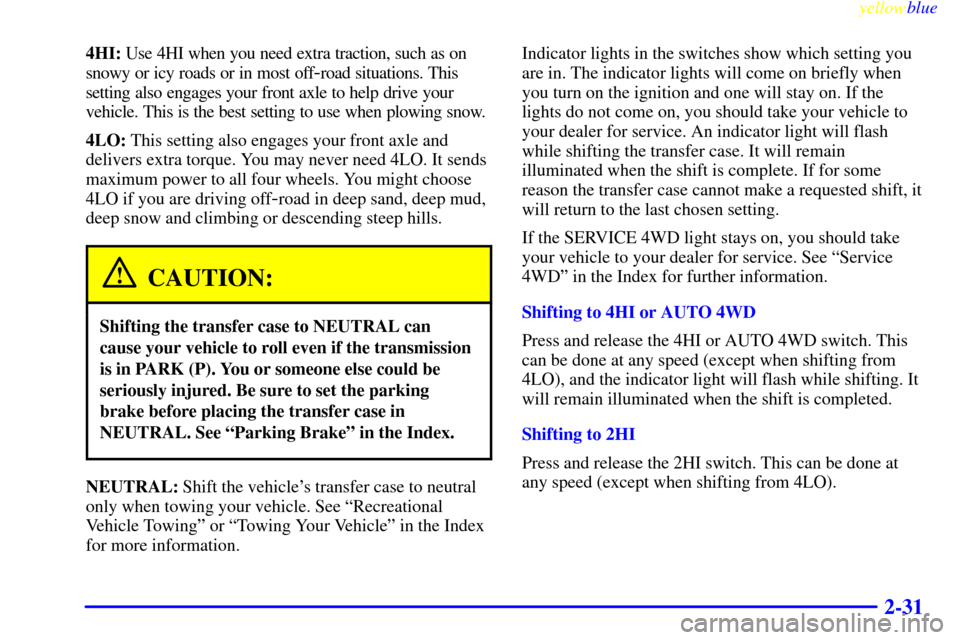Page 73 of 432

2-
yellowblue
2-1
Section 2 Features and Controls
Here you can learn about the many standard and optional features on your vehicle, and information on starting,
shifting and braking. Also explained are the instrument panel and the warning systems that tell you if everything is
working properly
-- and what to do if you have a problem.
2
-2 Keys
2
-3 Rear Access Door (Extended Cab)
2
-4 Door Locks
2
-6 Keyless Entry System (If Equipped)
2
-8 Tailgate
2
-10 Theft
2
-11 Content Theft-Deterrent (If Equipped)
2
-12 Passlock�
2-13 New Vehicle ªBreak-Inº
2
-13 Ignition Positions
2
-16 Starting Your Gasoline Engine
2
-19 Engine Coolant Heater (If Equipped)
2
-20 Automatic Transmission Operation
2
-24 Manual Transmission Operation
2
-27 Four-Wheel Drive (If Equipped)
2
-33 Parking Brake
2
-34 Shifting Into Park (P)
(Automatic Transmission Only)2
-37 Shifting Out of Park (P)
(Automatic Transmission)
2
-38 Parking Your Vehicle
(Manual Transmission Models Only)
2
-38 Parking Over Things That Burn
2
-39 Engine Exhaust
2
-40 Running Your Engine While You're Parked
(Automatic Transmission)
2
-41 Manual Selectable Ride (If Equipped)
2
-42 Locking Rear Axle
2
-42 Windows
2
-44 Turn Signal/Multifunction Lever
2
-51 Exterior Lamps
2
-54 Interior Lamps
2
-56 Mirrors
2
-66 Instrument Panel
2
-68 Instrument Panel Cluster
2
-70 Warning Lights, Gages and Indicators
2
-82 Message Center
Page 93 of 432

yellowblue
2-21
CAUTION: (Continued)
If you have four-wheel drive, your vehicle will
be free to roll
-- even if your shift lever is in
PARK (P)
-- if your transfer case is in
NEUTRAL (N). So, be sure the transfer case is
in a drive gear, two
-wheel high (2H) or
four
-wheel high (4H) or four-wheel low
(4L)
-- not in NEUTRAL (N). See ªShifting Into
PARK (P)º in the Index. If you're pulling a
trailer, see ªTowing a Trailerº in the Index.
REVERSE (R): Use this gear to back up.
NOTICE:
Shifting to REVERSE (R) while your vehicle is
moving forward could damage your transmission.
Shift to REVERSE (R) only after your vehicle
is stopped.
To rock your vehicle back and forth to get out of snow,
ice or sand without damaging your transmission, see
ªStuck: In Sand, Mud, Ice or Snowº in the Index.
NEUTRAL (N): In this position, your engine doesn't
connect with the wheels. To restart when you're already
moving, use NEUTRAL (N) only. Also, use
NEUTRAL (N) when your vehicle is being towed.
CAUTION:
Shifting out of PARK (P) or NEUTRAL (N) while
your engine is ªracingº (running at high speed) is
dangerous. Unless your foot is firmly on the
brake pedal, your vehicle could move very
rapidly. You could lose control and hit people or
objects. Don't shift out of PARK (P) or
NEUTRAL (N) while your engine is racing.
Page 99 of 432

yellowblue
2-27
Shift Light
If you have a manual
transmission, you may have
a SHIFT light. This light
will show you when to shift
to the next higher gear for
best fuel economy.
When this light comes on, you can shift to the next
higher gear if weather, road and traffic conditions allow.
For the best fuel economy, accelerate slowly and shift
when the light comes on.
While you accelerate, it is normal for the light to go
on and off if you quickly change the position of
the accelerator.
If your vehicle has four
-wheel drive and is equipped
with a manual transmission, disregard the SHIFT light
when the transfer case is in 4
-Wheel Low.
Ignore the SHIFT light when you downshift.
Four-Wheel Drive (If Equipped)
If your vehicle has four-wheel drive, you can send your
engine's driving power to all four wheels for extra
traction. To get the most satisfaction out of four
-wheel
drive, you must be familiar with its operation. Read the
part that follows before using four
-wheel drive. See the
appropriate text for the transfer case in your vehicle.
NOTICE:
Driving in the 4-WHEEL HIGH (4H) or
4
-WHEEL LOW (4L) positions for a long time
on dry or wet pavement could shorten the life of
your vehicle's drivetrain.
Front Axle Locking Feature
The front axle locks and unlocks automatically when
you shift the transfer case. Some delay for the axle to
lock or unlock is normal.
Page 100 of 432
yellowblue
2-28 Manual Transfer Case (If Equipped)
The transfer case shift lever is on the floor to the right of
the driver. Use this lever to shift into and out of
four
-wheel drive.
The 4WD indicator will
light up when you shift into
four
-wheel drive and the
front axle engages.Some delay between shifting and the indicator's lighting
is normal.
An indicator on the bezel near the lever shows you the
transfer case settings:
2
-Wheel High (2H): This setting is used for driving in
most street and highway situations. Your front axle is
not engaged in two
-wheel drive. This setting also
provides the best fuel economy.
4
-Wheel High (4H): Use 4HI when you need extra
traction, such as on snowy or icy roads or in most
off
-road situations. This setting also engages your front
axle to help drive your vehicle. This is the best setting to
use when plowing snow.
Page 101 of 432

yellowblue
2-29
CAUTION:
Shifting the transfer case to NEUTRAL (N) can
cause your vehicle to roll even if the transmission
is in PARK (P), or if you have a manual
transmission, even if you are in gear. You or
someone else could be seriously injured. Be sure
to set the parking brake before placing the
transfer case in NEUTRAL (N). See ªParking
Brakeº in the Index.
NEUTRAL (N): Shift to this setting only when your
vehicle needs to be towed. The ignition switch must be
in the RUN position in order to shift the lever into
NEUTRAL (N). See ªRecreational Vehicle
TowingºorªTowing your vehicleºin the Index.
4
-Wheel Low (4L): This setting also engages your
front axle and delivers extra torque. You may never need
4LO. It sends maximum power to all four wheels. You
might choose 4LO if you are driving off
-road in deep
sand, deep mud, deep snow and climbing or descending
steep hills.You can shift from 2
-Wheel High (2H) to 4-Wheel High
(4H) or from 4
-Wheel High (4H) to 2-Wheel High (2H)
while the vehicle is moving. Your front axle will engage
faster if you take your foot off of the accelerator for a
couple of seconds after you shift. In extremely cold
weather, it may be necessary to stop or slow the vehicle
to shift into 4
-Wheel High (4H).
To shift into or out of 4
-Wheel Low (4L) or
NEUTRAL (N):
1. Slow the vehicle to a roll, about 1 to 3 mph
(2 to 5 km/h) and shift an automatic transmission
into NEUTRAL (N), or with a manual transmission,
press the clutch pedal.
2. Shift the transfer case shift lever in one
continuous motion.
Don't pause in NEUTRAL (N) as you shift the transfer
case into 4
-Wheel Low (4L), or your gears could clash.
Remember that driving in 4
-Wheel High (4H) or
4
-Wheel Low (4L) may reduce fuel economy. Also,
driving in four
-wheel drive on dry pavement could
cause your tires to wear faster and make your transfer
case harder to shift and run noisier.
Page 102 of 432
yellowblue
2-30 Automatic Transfer Case (If Equipped)
The transfer case switches
are located to the left of the
instrument panel cluster.
Use these switches to shift into and out of
four
-wheel drive.
You can choose among four driving settings:
2HI: This setting is used for driving in most street and
highway situations. Your front axle is not engaged in
two
-wheel drive. This setting also provides the best fuel
economy.
AUTO 4WD: This setting is ideal for use when road
conditions are variable. When driving your vehicle in
AUTO 4WD, the front axle is engaged, but the vehicle's
power is sent only to the rear wheels. When the vehicle
senses a loss of traction, the system will automatically
engage four
-wheel drive. Driving in this mode results in
slightly lower fuel economy than 2HI.
Page 103 of 432

yellowblue
2-31
4HI: Use 4HI when you need extra traction, such as on
snowy or icy roads or in most off
-road situations. This
setting also engages your front axle to help drive your
vehicle. This is the best setting to use when plowing snow.
4LO: This setting also engages your front axle and
delivers extra torque. You may never need 4LO. It sends
maximum power to all four wheels. You might choose
4LO if you are driving off
-road in deep sand, deep mud,
deep snow and climbing or descending steep hills.
CAUTION:
Shifting the transfer case to NEUTRAL can
cause your vehicle to roll even if the transmission
is in PARK (P). You or someone else could be
seriously injured. Be sure to set the parking
brake before placing the transfer case in
NEUTRAL. See ªParking Brakeº in the Index.
NEUTRAL: Shift the vehicle's transfer case to neutral
only when towing your vehicle. See ªRecreational
Vehicle Towingº or ªTowing Your Vehicleº in the Index
for more information.Indicator lights in the switches show which setting you
are in. The indicator lights will come on briefly when
you turn on the ignition and one will stay on. If the
lights do not come on, you should take your vehicle to
your dealer for service. An indicator light will flash
while shifting the transfer case. It will remain
illuminated when the shift is complete. If for some
reason the transfer case cannot make a requested shift, it
will return to the last chosen setting.
If the SERVICE 4WD light stays on, you should take
your vehicle to your dealer for service. See ªService
4WDº in the Index for further information.
Shifting to 4HI or AUTO 4WD
Press and release the 4HI or AUTO 4WD switch. This
can be done at any speed (except when shifting from
4LO), and the indicator light will flash while shifting. It
will remain illuminated when the shift is completed.
Shifting to 2HI
Press and release the 2HI switch. This can be done at
any speed (except when shifting from 4LO).
Page 107 of 432
yellowblue
2-35
CAUTION: (Continued)
With four-wheel drive if your transfer case is in
NEUTRAL (N), your vehicle will be free to roll,
even if your shift lever is in PARK (P). So, be
sure the transfer case is in a drive gear
-- not in
NEUTRAL (N). If you're pulling a trailer, see
ªTowing a Trailerº in
the Index.
1. Hold the brake pedal down with your right foot and
set the parking brake.
2. Move the shift lever into PARK (P) position like this:
�Pull the shift lever toward you.